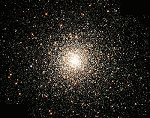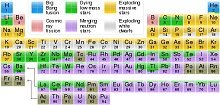All Elements Heavier Than Helium Are Metals?
|
|
1 | 2 | 3 | 4 | 5 | 6 | 7 | 8 | 9 | 10 | 11 | 12 | 13 | 14 | 15 | 16 | 17 | 18 | 19 | 20 | 21 | 22 | 23 | 24 | 25 | 26 | 27 | 28 | 29 | 30 | 31 | 32 | 33 | 34 | 35 | 36 | 37
Astronomers consider all elements heavier than helium to be metals. That definition obviously does not jive with the standard chemical definition of a metal as an element that readily conducts electricity, but a concept called "metallicity" argues that from a star (and therefore the universe) formation perspective, extremely high temperatures and pressures in first generation stars (like our sun) preclude the identification of distinct elements other than hydrogen and helium. Heavier elements, such as lithium (#3 on the periodic chart and a major component in LiIon batteries, is classified as a metal in chemistry) are overwhelmingly created after a massive enough hydrogen star collapses and begins fusing H and He into heavier elements. The relative abundance of hydrogen in the universe is deemed to be about 92%, and helium is 7.1%, so together they comprise about 99% of all elements. Universally, oxygen is at 0.1%, carbon is 0.06%, nitrogen is 0.015%, silicon is 0.006%, and iron is 0.004%. By comparison, the Earth's elemental composition is 48.8% oxygen, 14.3% iron, 13.8% silicon, 0.2% hydrogen, 0.02% carbon, 0.004% nitrogen, and <0.001% helium (which explains why He was first discovered in a spectrograph of the sun, which is 6% helium). As a point of interest, iron (Fe, #28) is the heaviest element that can be fused in a star and give off more energy than it takes to cause the fusion. Heavier elements require a net input of energy to fuse. How, then, are the heavier elements created if everything began with hydrogen? The violent gravitational collapse of a heavy star, known as a supernova, provides that needed energy, which subsequently causes a proportionally violent explosion spewing the newly created elements into the universe. The chart to the right shows by which process(es) the various elements are created.
Posted May 12, 2022 |
 "
"
